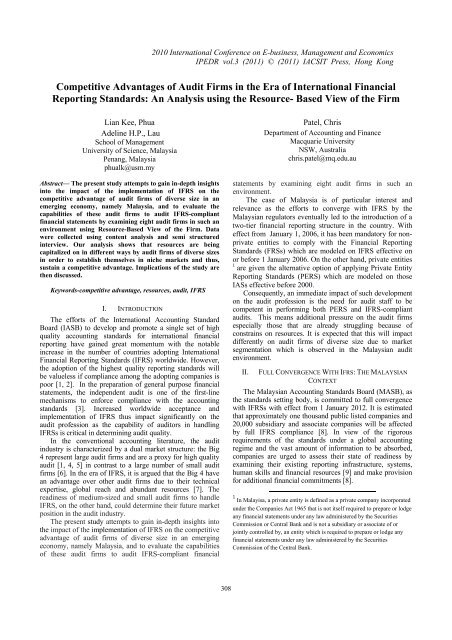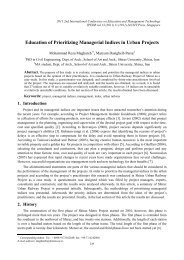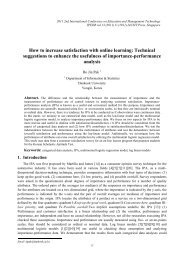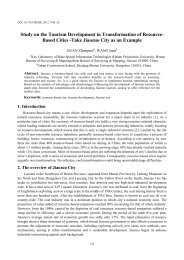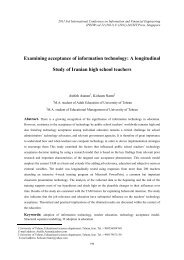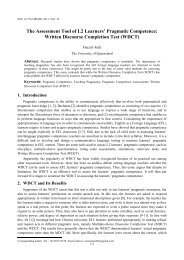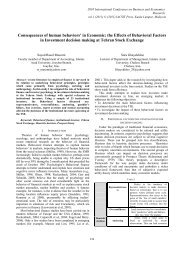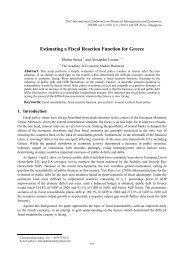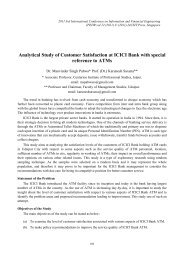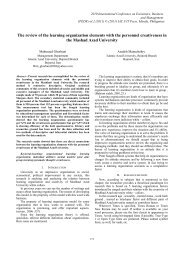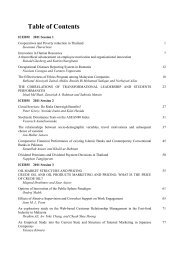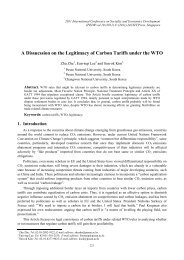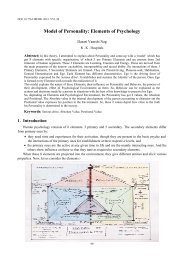Competitive Advantages of Audit Firms in the Era of ... - ipedr
Competitive Advantages of Audit Firms in the Era of ... - ipedr
Competitive Advantages of Audit Firms in the Era of ... - ipedr
You also want an ePaper? Increase the reach of your titles
YUMPU automatically turns print PDFs into web optimized ePapers that Google loves.
2010 International Conference on E-bus<strong>in</strong>ess, Management and Economics<br />
IPEDR vol.3 (2011) © (2011) IACSIT Press, Hong Kong<br />
<strong>Competitive</strong> <strong>Advantages</strong> <strong>of</strong> <strong>Audit</strong> <strong>Firms</strong> <strong>in</strong> <strong>the</strong> <strong>Era</strong> <strong>of</strong> International F<strong>in</strong>ancial<br />
Report<strong>in</strong>g Standards: An Analysis us<strong>in</strong>g <strong>the</strong> Resource- Based View <strong>of</strong> <strong>the</strong> Firm<br />
Lian Kee, Phua<br />
Adel<strong>in</strong>e H.P., Lau<br />
School <strong>of</strong> Management<br />
University <strong>of</strong> Science, Malaysia<br />
Penang, Malaysia<br />
phualk@usm.my<br />
Abstract— The present study attempts to ga<strong>in</strong> <strong>in</strong>-depth <strong>in</strong>sights<br />
<strong>in</strong>to <strong>the</strong> impact <strong>of</strong> <strong>the</strong> implementation <strong>of</strong> IFRS on <strong>the</strong><br />
competitive advantage <strong>of</strong> audit firms <strong>of</strong> diverse size <strong>in</strong> an<br />
emerg<strong>in</strong>g economy, namely Malaysia, and to evaluate <strong>the</strong><br />
capabilities <strong>of</strong> <strong>the</strong>se audit firms to audit IFRS-compliant<br />
f<strong>in</strong>ancial statements by exam<strong>in</strong><strong>in</strong>g eight audit firms <strong>in</strong> such an<br />
environment us<strong>in</strong>g Resource-Based View <strong>of</strong> <strong>the</strong> Firm. Data<br />
were collected us<strong>in</strong>g content analysis and semi structured<br />
<strong>in</strong>terview. Our analysis shows that resources are be<strong>in</strong>g<br />
capitalized on <strong>in</strong> different ways by audit firms <strong>of</strong> diverse sizes<br />
<strong>in</strong> order to establish <strong>the</strong>mselves <strong>in</strong> niche markets and thus,<br />
susta<strong>in</strong> a competitive advantage. Implications <strong>of</strong> <strong>the</strong> study are<br />
<strong>the</strong>n discussed.<br />
Keywords-competitive advantage, resources, audit, IFRS<br />
I. INTRODUCTION<br />
The efforts <strong>of</strong> <strong>the</strong> International Account<strong>in</strong>g Standard<br />
Board (IASB) to develop and promote a s<strong>in</strong>gle set <strong>of</strong> high<br />
quality account<strong>in</strong>g standards for <strong>in</strong>ternational f<strong>in</strong>ancial<br />
report<strong>in</strong>g have ga<strong>in</strong>ed great momentum with <strong>the</strong> notable<br />
<strong>in</strong>crease <strong>in</strong> <strong>the</strong> number <strong>of</strong> countries adopt<strong>in</strong>g International<br />
F<strong>in</strong>ancial Report<strong>in</strong>g Standards (IFRS) worldwide. However,<br />
<strong>the</strong> adoption <strong>of</strong> <strong>the</strong> highest quality report<strong>in</strong>g standards will<br />
be valueless if compliance among <strong>the</strong> adopt<strong>in</strong>g companies is<br />
poor [1, 2]. In <strong>the</strong> preparation <strong>of</strong> general purpose f<strong>in</strong>ancial<br />
statements, <strong>the</strong> <strong>in</strong>dependent audit is one <strong>of</strong> <strong>the</strong> first-l<strong>in</strong>e<br />
mechanisms to enforce compliance with <strong>the</strong> account<strong>in</strong>g<br />
standards [3]. Increased worldwide acceptance and<br />
implementation <strong>of</strong> IFRS thus impact significantly on <strong>the</strong><br />
audit pr<strong>of</strong>ession as <strong>the</strong> capability <strong>of</strong> auditors <strong>in</strong> handl<strong>in</strong>g<br />
IFRSs is critical <strong>in</strong> determ<strong>in</strong><strong>in</strong>g audit quality.<br />
In <strong>the</strong> conventional account<strong>in</strong>g literature, <strong>the</strong> audit<br />
<strong>in</strong>dustry is characterized by a dual market structure: <strong>the</strong> Big<br />
4 represent large audit firms and are a proxy for high quality<br />
audit [1, 4, 5] <strong>in</strong> contrast to a large number <strong>of</strong> small audit<br />
firms [6]. In <strong>the</strong> era <strong>of</strong> IFRS, it is argued that <strong>the</strong> Big 4 have<br />
an advantage over o<strong>the</strong>r audit firms due to <strong>the</strong>ir technical<br />
expertise, global reach and abundant resources [7]. The<br />
read<strong>in</strong>ess <strong>of</strong> medium-sized and small audit firms to handle<br />
IFRS, on <strong>the</strong> o<strong>the</strong>r hand, could determ<strong>in</strong>e <strong>the</strong>ir future market<br />
position <strong>in</strong> <strong>the</strong> audit <strong>in</strong>dustry.<br />
The present study attempts to ga<strong>in</strong> <strong>in</strong>-depth <strong>in</strong>sights <strong>in</strong>to<br />
<strong>the</strong> impact <strong>of</strong> <strong>the</strong> implementation <strong>of</strong> IFRS on <strong>the</strong> competitive<br />
advantage <strong>of</strong> audit firms <strong>of</strong> diverse size <strong>in</strong> an emerg<strong>in</strong>g<br />
economy, namely Malaysia, and to evaluate <strong>the</strong> capabilities<br />
<strong>of</strong> <strong>the</strong>se audit firms to audit IFRS-compliant f<strong>in</strong>ancial<br />
Patel, Chris<br />
Department <strong>of</strong> Account<strong>in</strong>g and F<strong>in</strong>ance<br />
Macquarie University<br />
NSW, Australia<br />
chris.patel@mq.edu.au<br />
statements by exam<strong>in</strong><strong>in</strong>g eight audit firms <strong>in</strong> such an<br />
environment.<br />
The case <strong>of</strong> Malaysia is <strong>of</strong> particular <strong>in</strong>terest and<br />
relevance as <strong>the</strong> efforts to converge with IFRS by <strong>the</strong><br />
Malaysian regulators eventually led to <strong>the</strong> <strong>in</strong>troduction <strong>of</strong> a<br />
two-tier f<strong>in</strong>ancial report<strong>in</strong>g structure <strong>in</strong> <strong>the</strong> country. With<br />
effect from January 1, 2006, it has been mandatory for nonprivate<br />
entities to comply with <strong>the</strong> F<strong>in</strong>ancial Report<strong>in</strong>g<br />
Standards (FRSs) which are modeled on IFRS effective on<br />
or before 1 January 2006. On <strong>the</strong> o<strong>the</strong>r hand, private entities<br />
1 are given <strong>the</strong> alternative option <strong>of</strong> apply<strong>in</strong>g Private Entity<br />
Report<strong>in</strong>g Standards (PERS) which are modeled on those<br />
IASs effective before 2000.<br />
Consequently, an immediate impact <strong>of</strong> such development<br />
on <strong>the</strong> audit pr<strong>of</strong>ession is <strong>the</strong> need for audit staff to be<br />
competent <strong>in</strong> perform<strong>in</strong>g both PERS and IFRS-compliant<br />
audits. This means additional pressure on <strong>the</strong> audit firms<br />
especially those that are already struggl<strong>in</strong>g because <strong>of</strong><br />
constra<strong>in</strong>s on resources. It is expected that this will impact<br />
differently on audit firms <strong>of</strong> diverse size due to market<br />
segmentation which is observed <strong>in</strong> <strong>the</strong> Malaysian audit<br />
environment.<br />
II. FULL CONVERGENCE WITH IFRS: THE MALAYSIAN<br />
CONTEXT<br />
The Malaysian Account<strong>in</strong>g Standards Board (MASB), as<br />
<strong>the</strong> standards sett<strong>in</strong>g body, is committed to full convergence<br />
with IFRSs with effect from 1 January 2012. It is estimated<br />
that approximately one thousand public listed companies and<br />
20,000 subsidiary and associate companies will be affected<br />
by full IFRS compliance [8]. In view <strong>of</strong> <strong>the</strong> rigorous<br />
requirements <strong>of</strong> <strong>the</strong> standards under a global account<strong>in</strong>g<br />
regime and <strong>the</strong> vast amount <strong>of</strong> <strong>in</strong>formation to be absorbed,<br />
companies are urged to assess <strong>the</strong>ir state <strong>of</strong> read<strong>in</strong>ess by<br />
exam<strong>in</strong><strong>in</strong>g <strong>the</strong>ir exist<strong>in</strong>g report<strong>in</strong>g <strong>in</strong>frastructure, systems,<br />
human skills and f<strong>in</strong>ancial resources [9] and make provision<br />
for additional f<strong>in</strong>ancial commitments [8].<br />
1 In Malayisa, a private entity is def<strong>in</strong>ed as a private company <strong>in</strong>corporated<br />
under <strong>the</strong> Companies Act 1965 that is not itself required to prepare or lodge<br />
any f<strong>in</strong>ancial statements under any law adm<strong>in</strong>istered by <strong>the</strong> Securities<br />
Commission or Central Bank and is not a subsidiary or associate <strong>of</strong> or<br />
jo<strong>in</strong>tly controlled by, an entity which is required to prepare or lodge any<br />
f<strong>in</strong>ancial statements under any law adm<strong>in</strong>istered by <strong>the</strong> Securities<br />
Commission <strong>of</strong> <strong>the</strong> Central Bank.<br />
308
As <strong>the</strong> forefront mechanism for enforc<strong>in</strong>g compliance<br />
with approved account<strong>in</strong>g standards, <strong>the</strong> build<strong>in</strong>g <strong>of</strong> a new<br />
set <strong>of</strong> skills among audit staff, and <strong>the</strong> availability <strong>of</strong> relevant<br />
resources are crucial <strong>in</strong> ensur<strong>in</strong>g that <strong>the</strong> whole set <strong>of</strong> IFRS is<br />
adequately handled. Previous studies have shown that<br />
<strong>in</strong>formation technology (IT) has significantly changed <strong>the</strong><br />
audit process and played an important role <strong>in</strong> determ<strong>in</strong><strong>in</strong>g <strong>the</strong><br />
effectiveness and efficiency <strong>of</strong> audit services [10-13].<br />
In Malaysia, non-Big 4 audit firms are also extensively<br />
engaged <strong>in</strong> <strong>the</strong> statutory audit <strong>of</strong> listed companies. This<br />
suggests that implementation <strong>of</strong> IFRS has important<br />
implications for smaller audit firms as well. To ga<strong>in</strong> fur<strong>the</strong>r<br />
<strong>in</strong>sights <strong>in</strong>to <strong>the</strong> read<strong>in</strong>ess <strong>of</strong> audit firms <strong>of</strong> diverse size to<br />
audit IFRS- compliant f<strong>in</strong>ancial statements, <strong>the</strong> present study<br />
attempts to draw on <strong>the</strong> resource-based view <strong>of</strong> a firm to<br />
exam<strong>in</strong>e i) <strong>the</strong> variations among audit firms <strong>of</strong> diverse size <strong>in</strong><br />
terms <strong>of</strong> <strong>the</strong>ir resources and ii) how resources controlled by<br />
different audit firms equip <strong>the</strong>m <strong>in</strong> susta<strong>in</strong><strong>in</strong>g <strong>the</strong>ir<br />
competitive advantage <strong>in</strong> response to new challenges<br />
triggered by <strong>the</strong> implementation <strong>of</strong> IFRSs. In particular, <strong>the</strong><br />
follow<strong>in</strong>g questions will be explored:<br />
1) How audit firms <strong>of</strong> diverse size vary <strong>in</strong> terms <strong>of</strong><br />
resources that provide competitive advantage to <strong>in</strong>dividual<br />
firms<br />
2) Whe<strong>the</strong>r resources and capabilities <strong>of</strong> audit firms<br />
enable <strong>the</strong>m to respond to <strong>the</strong> environmental threats and<br />
opportunities that have resulted from implementation <strong>of</strong><br />
IFRS<br />
III.<br />
THEORETICAL FRAMEWORK AND RESEARCH<br />
METHODS<br />
A. Resource-Based View <strong>of</strong> <strong>the</strong> Firm (RBV)<br />
Build<strong>in</strong>g upon <strong>the</strong> argument that <strong>the</strong> competitive<br />
advantage or success <strong>of</strong> a firm is largely determ<strong>in</strong>ed by <strong>the</strong><br />
resources it controls, <strong>the</strong> RBV <strong>of</strong> a firm has gradually ga<strong>in</strong>ed<br />
considerable <strong>in</strong>terest among scholars. Barney [14] <strong>in</strong>troduced<br />
a <strong>the</strong>oretical framework <strong>of</strong> RBV based on <strong>the</strong> assumptions<br />
that resources are heterogeneously distributed among firms<br />
and imperfectly mobile. The framework prescribes value,<br />
be<strong>in</strong>g rare, imperfectly imitable and non-substitutable as <strong>the</strong><br />
four criteria <strong>of</strong> resources which enable a firm to ga<strong>in</strong> a<br />
susta<strong>in</strong>able competitive advantage. The model, however, has<br />
be<strong>in</strong>g criticized for fail<strong>in</strong>g to expla<strong>in</strong> <strong>the</strong> process through<br />
which a firm can achieve its competition advantage.<br />
Follow<strong>in</strong>g which,Barney [15] attempted to revise <strong>the</strong><br />
framework and emphasized that a firm also needed to be<br />
organized <strong>in</strong> such a way that it could exploit <strong>the</strong> full potential<br />
<strong>of</strong> its resources <strong>in</strong> order to atta<strong>in</strong> competitive advantage.<br />
The application <strong>of</strong> <strong>the</strong> RBV to <strong>the</strong> audit <strong>in</strong>dustry has been<br />
demonstrated by Maijoor and Witteloostuijn [6] who<br />
exam<strong>in</strong>ed <strong>the</strong> Dutch audit <strong>in</strong>dustry. Under <strong>the</strong> RBV, a<br />
resource must first be valuable and scarce to have a rentproduc<strong>in</strong>g<br />
potential. This is atta<strong>in</strong>ed through <strong>the</strong> imperfection<br />
<strong>of</strong> <strong>the</strong> product market for audit services created from <strong>the</strong><br />
regulatory requirements which generate consistent demand <strong>in</strong><br />
<strong>the</strong> market. At <strong>the</strong> same time, regulations also make <strong>the</strong><br />
resources imperfectly imitable and imperfectly substitutable<br />
by outside firms as <strong>the</strong> barriers <strong>of</strong> entry to restrict entrants<br />
from related or unrelated <strong>in</strong>dustries.<br />
In <strong>the</strong> context <strong>of</strong> Malaysia, <strong>the</strong> statutory requirements, <strong>in</strong><br />
particular, <strong>the</strong> Companies Act, 1965 which mandates all<br />
companies to submit annual audited accounts, create a<br />
consistent demand for <strong>the</strong> production <strong>of</strong> audit services. On<br />
<strong>the</strong> supply side, only chartered accountants registered with<br />
<strong>the</strong> Malaysian Institute <strong>of</strong> Accountants (MIA) who have<br />
valid practic<strong>in</strong>g certificate are allowed to set up firms to<br />
provide public practice services under <strong>the</strong> Accountants Act,<br />
1967. Both conditions set a platform for audit firms <strong>of</strong><br />
diverse size to have a presence <strong>in</strong> <strong>the</strong> audit <strong>in</strong>dustry.<br />
In l<strong>in</strong>e with <strong>the</strong> nature <strong>of</strong> audit<strong>in</strong>g activities and<br />
requirements, <strong>the</strong> present study follows Newbert [16] and<br />
classifies resources <strong>in</strong>to five major categories for <strong>the</strong><br />
purposes <strong>of</strong> data collection and analysis namely, f<strong>in</strong>ancial<br />
resources, human resources, <strong>in</strong>tellectual resources,<br />
organisational resources and physical resources.<br />
B. Data Collection<br />
A content analysis was first conducted from <strong>the</strong> websites<br />
<strong>of</strong> each <strong>of</strong> <strong>the</strong> sample audit firms with <strong>the</strong> aim <strong>of</strong> collect<strong>in</strong>g<br />
data about <strong>the</strong> background and characteristics <strong>of</strong> <strong>the</strong> audit<br />
firms as well as resources available to <strong>the</strong> firms. Then, semistructured<br />
<strong>in</strong>terviews were conducted with <strong>the</strong> audit<br />
partners/managers <strong>of</strong> eight audit firms located <strong>in</strong> nor<strong>the</strong>rn<br />
Malaysia. <strong>Audit</strong> firms <strong>of</strong> different sizes and ownership<br />
characteristics were selected to provide rich data for crosscase<br />
analysis. The <strong>in</strong>terviews were based on a list <strong>of</strong><br />
questions prepared by <strong>the</strong> researchers. To ensure consistency<br />
and reliability, standard <strong>in</strong>terview guides were used for <strong>the</strong><br />
<strong>in</strong>terviews [17].<br />
IV. DISCUSSIONS<br />
An analysis <strong>of</strong> <strong>the</strong> characteristics <strong>of</strong> <strong>the</strong> sample firms is<br />
shown <strong>in</strong> Table 1. The sample firms are labeled as Firm A to<br />
Firm H. Based on <strong>the</strong> number <strong>of</strong> employees, <strong>Firms</strong> A and B<br />
are considered small audit firms while <strong>Firms</strong> C, D, E and F<br />
are classified as medium- sized audit firms and <strong>Firms</strong> G and<br />
H represent big audit firms. Analysis <strong>in</strong> terms <strong>of</strong> clientele<br />
shows that firms A and B concentrate on clients from small<br />
and medium enterprises (SMEs). On <strong>the</strong> o<strong>the</strong>r hand, <strong>Firms</strong> G<br />
and H only serve medium to big corporations while <strong>Firms</strong> C,<br />
D, E and F cater for both small companies as well as big<br />
corporations.<br />
TABLE I. CHARACTERISTICS OF THE SAMPLE FIRMS<br />
Sample<br />
<strong>Firms</strong><br />
A B C D E F G H<br />
Firm size small Medium size Large<br />
Number <strong>of</strong><br />
employees<br />
Ownership<br />
structure<br />
Less than 50<br />
employees<br />
Sole<br />
proprietor<br />
100 to 300<br />
employees<br />
Partnerships<br />
Clientele SMEs SMEs and big<br />
corporations<br />
More than 1500<br />
employees<br />
Partnerships<br />
Medium size<br />
firms, MNCs<br />
and listed firms<br />
309
Years <strong>of</strong><br />
operation<br />
Less<br />
than 10<br />
years<br />
More than 20 years More than 50<br />
years<br />
A. Physical Resources<br />
<strong>Firms</strong> A, B, C, D and E use Micros<strong>of</strong>t Office as <strong>the</strong> ma<strong>in</strong><br />
s<strong>of</strong>tware to perform <strong>the</strong>ir audit tasks. Micros<strong>of</strong>t Word and<br />
Excel templates are widely used to prepare complicated<br />
schedules, to perform complex computations and repetitive<br />
tasks, to replace hand-written audit work<strong>in</strong>g paper and to<br />
generate f<strong>in</strong>ancial statements and reports. The templates are<br />
designed by <strong>the</strong> audit staff <strong>the</strong>mselves and <strong>in</strong>tegrated<br />
work<strong>in</strong>g papers are generated us<strong>in</strong>g <strong>the</strong> templates created by<br />
Excel. The hard copies <strong>of</strong> <strong>the</strong> work<strong>in</strong>g papers are still pr<strong>in</strong>ted<br />
for review by a superior/partner. All <strong>the</strong> <strong>of</strong>fices have <strong>the</strong>ir<br />
own servers for database management, network<strong>in</strong>g with<strong>in</strong> <strong>the</strong><br />
firm and shar<strong>in</strong>g <strong>of</strong> data among <strong>the</strong> work groups. The<br />
manager <strong>of</strong> Firm B po<strong>in</strong>ted out that IT is essential <strong>in</strong> <strong>the</strong><br />
production <strong>of</strong> audit services as <strong>the</strong> use <strong>of</strong> computers does<br />
<strong>in</strong>creases <strong>the</strong> level <strong>of</strong> efficiency.<br />
Based on <strong>the</strong> above observations, it is suggested that<br />
generic computer s<strong>of</strong>tware and basic IT facilities used by<br />
firms A, B, C, D and E <strong>in</strong> <strong>the</strong> production <strong>of</strong> audit services do<br />
not provide <strong>the</strong> competitive advantage for <strong>the</strong>se firms to<br />
compete <strong>in</strong> <strong>the</strong> markets, as suggested by <strong>the</strong> resource-based<br />
view <strong>of</strong> firms. The size <strong>of</strong> <strong>the</strong> firms also <strong>in</strong>dicates that <strong>the</strong>se<br />
firms do not possess <strong>the</strong> economy <strong>of</strong> scale to acquire<br />
sophisticated computer <strong>in</strong>frastructure and IT.<br />
B. Intellectual Resources<br />
<strong>Firms</strong> F, G and H use proprietary <strong>in</strong>-house s<strong>of</strong>tware<br />
developed by <strong>the</strong>ir <strong>in</strong>ternational HQs. These globally<br />
developed audit support systems are <strong>the</strong>n tailored to achieve<br />
compliance with country-specific standards. A significant<br />
f<strong>in</strong>ancial contribution is required <strong>of</strong> each local practice entity<br />
<strong>in</strong> fund<strong>in</strong>g <strong>the</strong> cont<strong>in</strong>uous development <strong>of</strong> <strong>the</strong> various types<br />
<strong>of</strong> proprietary <strong>in</strong>-house s<strong>of</strong>tware. In addition, each branch<br />
<strong>of</strong>fice has at least one <strong>in</strong>ternal full-time IT employee with<br />
computer-troubleshoot<strong>in</strong>g capabilities to take care <strong>of</strong> <strong>the</strong><br />
technical aspects <strong>of</strong> computer hardware and s<strong>of</strong>tware.<br />
Firm H revealed that <strong>the</strong>y have two sets <strong>of</strong> audit s<strong>of</strong>tware<br />
<strong>in</strong> each <strong>of</strong> <strong>the</strong>ir <strong>of</strong>fices which are used depend<strong>in</strong>g on <strong>the</strong> size<br />
<strong>of</strong> clients. In addition, for <strong>the</strong> listed companies and MNCs<br />
that make up <strong>the</strong> majority <strong>of</strong> <strong>the</strong> clients <strong>of</strong> <strong>the</strong>se audit firms,<br />
<strong>the</strong> use <strong>of</strong> commercially produced computer-assisted audit<br />
techniques (CAATs) is also common. As such, <strong>the</strong>se firms<br />
use audit s<strong>of</strong>tware to assess <strong>the</strong> client’s account<strong>in</strong>g systems<br />
and to obta<strong>in</strong> audit evidence. These firms are well on track<br />
towards creat<strong>in</strong>g paperless audit<strong>in</strong>g. The proprietary <strong>in</strong>-house<br />
s<strong>of</strong>tware employed by firms F, G and H meets those criteria<br />
<strong>of</strong> not be<strong>in</strong>g perfectly imitable and substitutable, hence<br />
provid<strong>in</strong>g competitive advantage to <strong>the</strong>se firms.<br />
C. Human Resources<br />
Staff tra<strong>in</strong><strong>in</strong>g provided by Firm G and H is formal and<br />
well structured. It is standard practice among <strong>the</strong> firms to<br />
require all staff to atta<strong>in</strong> a specified number <strong>of</strong> hours <strong>of</strong><br />
cont<strong>in</strong>u<strong>in</strong>g pr<strong>of</strong>essional education (CPE hours) annually.<br />
These CPE hours are also recognized by national and<br />
<strong>in</strong>ternational pr<strong>of</strong>essional bodies for Cont<strong>in</strong>u<strong>in</strong>g Pr<strong>of</strong>essional<br />
Development (CPD) requirements. The number <strong>of</strong> hours to<br />
be atta<strong>in</strong>ed is captured and closely monitored by <strong>the</strong><br />
<strong>in</strong>formation system <strong>of</strong> <strong>the</strong> firm. It is also used for<br />
performance appraisal and forms part <strong>of</strong> <strong>the</strong> promotion<br />
criteria. As noted by Firm G, a new staff needs to pass 7 e-<br />
learn<strong>in</strong>g tests <strong>in</strong> order to be confirmed or promoted as a<br />
permanent member <strong>of</strong> staff. As such, staff <strong>in</strong> both <strong>Firms</strong> G<br />
and H are regularly tra<strong>in</strong>ed and equipped to handle <strong>the</strong> latest<br />
updates on account<strong>in</strong>g standards which at <strong>the</strong> same time<br />
ma<strong>in</strong>ta<strong>in</strong>s <strong>the</strong> <strong>in</strong>ternational reputation <strong>of</strong> <strong>the</strong>se firms. Onl<strong>in</strong>e<br />
tra<strong>in</strong><strong>in</strong>g is widely used with a wide range <strong>of</strong> tra<strong>in</strong><strong>in</strong>g<br />
materials available on <strong>the</strong> web. IT tra<strong>in</strong><strong>in</strong>g forms an<br />
important aspect <strong>of</strong> <strong>the</strong> tra<strong>in</strong><strong>in</strong>g <strong>of</strong> staff and <strong>the</strong> firms use <strong>in</strong>house<br />
s<strong>of</strong>tware developed by <strong>the</strong>ir <strong>in</strong>ternational partners. The<br />
staff is also tra<strong>in</strong>ed on us<strong>in</strong>g audit s<strong>of</strong>tware on client’s<br />
account<strong>in</strong>g systems us<strong>in</strong>g such s<strong>of</strong>tware as Oracle, JD<br />
Edward and ERP. As such, <strong>the</strong> staff <strong>in</strong> <strong>the</strong>se firms receives<br />
more exposure to technology and greater pr<strong>of</strong>essional<br />
development compared to staff work<strong>in</strong>g <strong>in</strong> <strong>the</strong> o<strong>the</strong>r 6 audit<br />
firms sampled <strong>in</strong> this study.<br />
For Firm A, all <strong>the</strong> tra<strong>in</strong><strong>in</strong>g is conducted at its own<br />
premises by <strong>the</strong> owner himself and none <strong>of</strong> <strong>the</strong> staff is<br />
pursu<strong>in</strong>g a pr<strong>of</strong>essional qualifications. For <strong>Firms</strong> B, C and<br />
D, audit staff needs to refer to a more experienced person for<br />
assistance whenever <strong>the</strong>y encounter problems with <strong>the</strong> use <strong>of</strong><br />
electronic work papers or s<strong>of</strong>tware. The tra<strong>in</strong><strong>in</strong>g is <strong>in</strong>formal<br />
and hands-on. Formal tra<strong>in</strong><strong>in</strong>g sessions are usually only held<br />
upon <strong>the</strong> release <strong>of</strong> new account<strong>in</strong>g standards. For Firm F,<br />
<strong>the</strong> <strong>in</strong>ternational head <strong>of</strong>fice (HQ) does specify m<strong>in</strong>imum<br />
requirements for CPE. However, <strong>the</strong> number <strong>of</strong> hours to be<br />
fulfilled is ultimately determ<strong>in</strong>ed by <strong>the</strong> local HQ.<br />
In terms <strong>of</strong> staff recruitment, some obvious differences<br />
were observed among <strong>the</strong>se firms. <strong>Firms</strong> G and H be<strong>in</strong>g Big<br />
4 practice entities pay new recruits who are university<br />
graduates a start<strong>in</strong>g salary which is between twenty and forty<br />
percent more than medium sized firms. On <strong>the</strong> o<strong>the</strong>r hand,<br />
medium sized firms pay a twenty to thirty percent premium<br />
as compared to small audit firms. In addition, Big 4 firms<br />
impose more str<strong>in</strong>gent selection criteria <strong>in</strong> <strong>the</strong>ir recruitment<br />
<strong>of</strong> fresh graduates. Basically, only graduates who have<br />
performed well <strong>in</strong> university and achieved at least a CGPA<br />
<strong>of</strong> 3.5 po<strong>in</strong>ts/4 are shortlisted for a job <strong>in</strong>terview.<br />
D. F<strong>in</strong>ancial Resources<br />
As a sole proprietorship, <strong>the</strong> capital available to <strong>Firms</strong> A<br />
and B is limited. <strong>Firms</strong> G and H demonstrated <strong>the</strong> strongest<br />
f<strong>in</strong>ancial resources, <strong>the</strong> amount vary<strong>in</strong>g accord<strong>in</strong>g to <strong>the</strong><br />
number <strong>of</strong> partners. Firm A and B rely solely on clients that<br />
are private limited companies and SMEs to generate audit<br />
revenues. With regards to audit fees charged to clients, Firm<br />
A <strong>in</strong>dicated that <strong>the</strong> markets for small audit firms was very<br />
competitive and <strong>the</strong> fees charged by <strong>the</strong> firm were much<br />
lower compared to medium-sized audit firms or Big 4 <strong>Firms</strong>.<br />
Firm A also revealed that <strong>the</strong> major operat<strong>in</strong>g cost <strong>of</strong> <strong>the</strong><br />
firm was staff costs while <strong>the</strong> <strong>in</strong>vestment <strong>in</strong> IT was m<strong>in</strong>imal<br />
result<strong>in</strong>g <strong>in</strong> lower costs. Such a policy allows <strong>the</strong> firm to<br />
ma<strong>in</strong>ta<strong>in</strong> low audit fees and to susta<strong>in</strong> <strong>the</strong>ir clients. The<br />
manager <strong>of</strong> Firm E <strong>in</strong>dicated that as a mid-size firm, <strong>the</strong> fees<br />
that <strong>the</strong> firm charged are higher as compared to small audit<br />
310
firms but much lower than those charged by <strong>the</strong> Big4 <strong>Firms</strong>.<br />
A partner <strong>in</strong> Firm G, on <strong>the</strong> o<strong>the</strong>r hand, revealed that <strong>the</strong>y do<br />
not service small firms as <strong>the</strong>se firms could not afford <strong>the</strong><br />
fees <strong>the</strong>y charged. The partner added that <strong>the</strong>y had to charge<br />
a premium on <strong>the</strong> fees as <strong>the</strong>y <strong>in</strong>curred a heavy <strong>in</strong>vestment to<br />
susta<strong>in</strong> <strong>the</strong>ir quality. He also stated that <strong>the</strong>ir firm was not<br />
audit<strong>in</strong>g small clients as it was not economically feasible for<br />
<strong>the</strong> Big4 firms to serve this market. These small firms cannot<br />
afford <strong>the</strong> fees charged by <strong>the</strong> Big4 <strong>Firms</strong>.<br />
E. Organizational Resources<br />
All <strong>of</strong> <strong>the</strong> eight audit firms have established websites. As<br />
noted <strong>in</strong> <strong>the</strong> content analysis, a website is widely used by<br />
firms as a means <strong>of</strong> <strong>in</strong>troduc<strong>in</strong>g <strong>the</strong> firm to prospective<br />
clients on <strong>the</strong> range <strong>of</strong> services available. As stated by a<br />
manager <strong>of</strong> Firm A, <strong>the</strong> purpose <strong>of</strong> <strong>the</strong> website is to create<br />
awareness among potential users and clients with regards to<br />
<strong>the</strong> existence, location, contact details and services provided<br />
by <strong>the</strong> firm. In addition, it is also widely used as a means <strong>of</strong><br />
job recruitment by enabl<strong>in</strong>g prospective employees to submit<br />
job applications for advertised ob vacancies on-l<strong>in</strong>e.<br />
Websites are also used to advertise <strong>the</strong> specialized services<br />
available to specific <strong>in</strong>dustries <strong>in</strong> <strong>the</strong> case <strong>of</strong> <strong>Firms</strong> G and H.<br />
All <strong>the</strong> staff <strong>in</strong> <strong>the</strong> sample firms has access to <strong>the</strong><br />
Internet. The Internet is ma<strong>in</strong>ly used by staff to research<br />
resources relevant to <strong>the</strong>ir work. Staff uses email to<br />
communicate with clients and some files are sent via email.<br />
Email is also used to send files to partners <strong>in</strong> o<strong>the</strong>r <strong>of</strong>fices for<br />
review. Staff <strong>of</strong> <strong>Firms</strong> G and H is expected to use web<br />
brows<strong>in</strong>g for <strong>the</strong> latest updates on account<strong>in</strong>g and audit<strong>in</strong>g<br />
standards, as well as for cont<strong>in</strong>u<strong>in</strong>g education through e-<br />
learn<strong>in</strong>g and webcasts. A large variety <strong>of</strong> <strong>in</strong>-house resources<br />
can be accessed by staff through <strong>the</strong> Intranet. All <strong>the</strong> staff <strong>in</strong><br />
<strong>Firms</strong> G and H is assigned <strong>the</strong>ir own <strong>in</strong>tra-firm e-mail<br />
account.<br />
Five <strong>of</strong> <strong>the</strong> audit firms have established <strong>in</strong>ternational<br />
affiliations to widen <strong>the</strong>ir network<strong>in</strong>g with o<strong>the</strong>r audit firms<br />
worldwide. <strong>Firms</strong> F, G and H have a highly structured<br />
network <strong>in</strong> which all member firms are required to apply<br />
standardized audit methodology developed for <strong>the</strong> group.<br />
Brand name reputation and potential to share <strong>in</strong>formation<br />
and expertise are <strong>the</strong> ma<strong>in</strong> reasons for <strong>the</strong>se firms<br />
establish<strong>in</strong>g <strong>in</strong>ternational affiliations. A manager <strong>of</strong> Firm E<br />
expects that while more firms will cont<strong>in</strong>ue to seek<br />
<strong>in</strong>ternational affiliations <strong>in</strong> <strong>the</strong> future, currently member<br />
firms <strong>of</strong> <strong>the</strong> group still want to reta<strong>in</strong> autonomy <strong>in</strong> decid<strong>in</strong>g<br />
on <strong>the</strong>ir own audit procedures. At present, <strong>the</strong> nature <strong>of</strong> <strong>the</strong><br />
relationship is ma<strong>in</strong>ly <strong>in</strong> <strong>the</strong> shar<strong>in</strong>g <strong>of</strong> resources such as<br />
expertise and new knowledge as well as shar<strong>in</strong>g clients who<br />
operate <strong>in</strong> different locations.<br />
Firm C is a member <strong>of</strong> an <strong>in</strong>ternational association <strong>of</strong><br />
<strong>in</strong>dependent audit<strong>in</strong>g, account<strong>in</strong>g and consult<strong>in</strong>g firms. As a<br />
member, Firm C has to pay an annual fee to <strong>the</strong> association.<br />
As noted by <strong>the</strong> partner, <strong>the</strong> purpose is to stay connected<br />
with o<strong>the</strong>r audit firms <strong>in</strong>ternationally so that <strong>the</strong>y are<br />
exposed to diverse bus<strong>in</strong>ess practices <strong>in</strong> o<strong>the</strong>r parts <strong>of</strong> <strong>the</strong><br />
world.<br />
Firm A, B and D tend to focus on local network<strong>in</strong>g.<br />
Possibly due to <strong>the</strong> smaller size <strong>of</strong> <strong>the</strong>ir operations, <strong>the</strong>se<br />
firms seek to build network<strong>in</strong>g and relationships with o<strong>the</strong>r<br />
local firms, prior to decid<strong>in</strong>g to jo<strong>in</strong> <strong>in</strong>ternational practice<br />
entities or affiliations. <strong>Firms</strong> A and D have attempted to<br />
widen <strong>the</strong>ir networks by establish<strong>in</strong>g l<strong>in</strong>kages with service<br />
providers from o<strong>the</strong>r discipl<strong>in</strong>es such as management<br />
consultants, taxation, account<strong>in</strong>g and secretarial services.<br />
Accord<strong>in</strong>g to a manager <strong>of</strong> Firm D, such l<strong>in</strong>kages serve as a<br />
source <strong>of</strong> new clients. Firm B is jo<strong>in</strong><strong>in</strong>g a locally established<br />
group <strong>of</strong> firms <strong>of</strong>fer<strong>in</strong>g audit and assurance, tax and<br />
consultancy services.<br />
F. Analysis <strong>of</strong> <strong>Competitive</strong> <strong>Advantages</strong><br />
The above analysis shows that resources are be<strong>in</strong>g<br />
capitalized on <strong>in</strong> different ways by audit firms <strong>of</strong> diverse<br />
sizes <strong>in</strong> order to establish <strong>the</strong>mselves <strong>in</strong> niche markets and<br />
thus, susta<strong>in</strong> a competitive advantage.<br />
In particular, small audit firms, due to <strong>the</strong>ir size and<br />
limited access to capital, have attempted to ga<strong>in</strong> market share<br />
by charg<strong>in</strong>g clients <strong>the</strong> lowest audit fees possible. This is<br />
made possible by capitaliz<strong>in</strong>g on a comb<strong>in</strong>ation <strong>of</strong> resources<br />
that allow <strong>the</strong> firms to m<strong>in</strong>imize <strong>the</strong>ir operat<strong>in</strong>g costs. These<br />
firms thus <strong>in</strong>vest <strong>in</strong> generic IT system that cost less, pay<br />
relatively lower salaries as compared to bigger audit firms<br />
and focus on <strong>the</strong> establishment <strong>of</strong> local networks from<br />
related discipl<strong>in</strong>es to assist <strong>in</strong> gett<strong>in</strong>g more clients. As noted<br />
by a manager from Firm A, <strong>the</strong> largest cost element to <strong>the</strong><br />
firm is staff costs.<br />
Meanwhile, mid-sized firms with a larger pool <strong>of</strong><br />
pr<strong>of</strong>essional expertise as compared to small audit firms are<br />
able to serve small companies as well as to tap <strong>the</strong> market for<br />
bigger companies. The analysis shows that <strong>the</strong>se firms were<br />
able to reduce <strong>the</strong>ir operat<strong>in</strong>g costs by <strong>in</strong>vest<strong>in</strong>g less <strong>in</strong><br />
certa<strong>in</strong> resources as compared to Big4 <strong>Firms</strong>. On <strong>the</strong> o<strong>the</strong>r<br />
hand, <strong>the</strong>se mid-sized audit firms <strong>of</strong>fer more attractive<br />
remuneration as compared to small audit firms and provide<br />
more opportunities for career advancement due to <strong>the</strong><br />
availability <strong>of</strong> more job positions. Accord<strong>in</strong>g to <strong>the</strong> manager<br />
<strong>of</strong> Firm E, <strong>the</strong> opportunity <strong>of</strong> becom<strong>in</strong>g a partner is also<br />
higher for some mid-sized firms as compared to <strong>the</strong> Big4<br />
<strong>Firms</strong>.<br />
On <strong>the</strong> o<strong>the</strong>r hand, because <strong>of</strong> <strong>the</strong>ir size and ability to<br />
enjoy certa<strong>in</strong> economies <strong>of</strong> scale, Big 4 firms are <strong>in</strong> a<br />
position to provide <strong>the</strong> full range <strong>of</strong> services to <strong>the</strong> larger<br />
commercial firms. One <strong>of</strong> <strong>the</strong> important factors <strong>in</strong> attract<strong>in</strong>g<br />
large clients is <strong>the</strong> existence <strong>of</strong> <strong>the</strong> <strong>in</strong>ternational audit firm<br />
network that is highly organized among <strong>the</strong>se firms. As<br />
noted by[1], <strong>the</strong> existence <strong>of</strong> <strong>in</strong>ternational audit networks<br />
among <strong>the</strong> large <strong>in</strong>ternational firms allows <strong>the</strong>se firms to<br />
build <strong>the</strong>ir audit capabilities rapidly by transferr<strong>in</strong>g audit<br />
technology and key personnel to affiliated firms. In addition,<br />
<strong>the</strong>se firms also possess advantages over domestic audit<br />
firms <strong>in</strong> that <strong>the</strong>y have access to global <strong>in</strong>dustry specialists<br />
who provide competitive advantages <strong>in</strong> terms <strong>of</strong> vast<br />
knowledge about various bus<strong>in</strong>ess practices <strong>in</strong> diverse<br />
environments, exceptional brand image, vigorous audit<br />
methodology and processes, highly-skilled and<br />
knowledgeable pr<strong>of</strong>essional staff, expertise developed from<br />
handl<strong>in</strong>g clients <strong>in</strong> numerous locations and <strong>the</strong> capability <strong>of</strong><br />
develop<strong>in</strong>g <strong>in</strong>dustry tra<strong>in</strong><strong>in</strong>g and protocols [1]. When audit<br />
311
firms become <strong>in</strong>dustry specialists, barriers to entry <strong>in</strong>to <strong>the</strong><br />
audit market <strong>in</strong>creases [1, 18]. In summary, different<br />
comb<strong>in</strong>ations <strong>of</strong> resources controlled by audit firms <strong>of</strong><br />
diverse sizes have allowed <strong>the</strong>m to ga<strong>in</strong> a competitive<br />
advantage and to ensure <strong>the</strong>ir cont<strong>in</strong>ued existence <strong>in</strong> <strong>the</strong><br />
audit <strong>in</strong>dustry.<br />
Follow<strong>in</strong>g <strong>the</strong> implementation <strong>of</strong> IFRS <strong>in</strong> 2006, all nonprivate<br />
entities are required to comply with <strong>in</strong>ternational<br />
standards. On <strong>the</strong> o<strong>the</strong>r hand, most private entities have<br />
opted to apply PERS due to <strong>the</strong>ir relative simplicity. This<br />
two- tier report<strong>in</strong>g system impacts differently on audit firms<br />
<strong>of</strong> diverse size and has important implications for <strong>the</strong><br />
competitive advantage <strong>of</strong> <strong>in</strong>dividual audit firms.<br />
Specifically, <strong>the</strong> breadth and volume <strong>of</strong> knowledge and<br />
expertise required to ensure compliance with IFRS place an<br />
enormous responsibility on audit pr<strong>of</strong>essionals to build up<br />
and cont<strong>in</strong>uously upgrade <strong>the</strong> capacity <strong>of</strong> <strong>the</strong>ir firms to<br />
rema<strong>in</strong> competitive <strong>in</strong> <strong>the</strong> chang<strong>in</strong>g audit environment.<br />
However, such needs vary among audit firms depend<strong>in</strong>g on<br />
<strong>the</strong>ir size and target market sectors.<br />
The impact <strong>of</strong> IFRS implementation is most strongly felt<br />
by medium- sized audit firms. From <strong>the</strong> analysis, <strong>the</strong>se firms<br />
can be seen to serve a mixture <strong>of</strong> clients <strong>in</strong> terms <strong>of</strong> size. The<br />
bigger clients <strong>of</strong> <strong>the</strong>se firms comprise listed companies and<br />
mult<strong>in</strong>ational corporations. At <strong>the</strong> same time, SMEs also<br />
contribute a significant portion <strong>of</strong> <strong>the</strong>ir audit revenues.<br />
Growth <strong>of</strong> <strong>the</strong>se firms rests on <strong>the</strong> ability <strong>of</strong> <strong>the</strong> audit firm to<br />
get larger clients.<br />
To susta<strong>in</strong> <strong>the</strong>ir competitiveness and cont<strong>in</strong>ue to serve<br />
large clients who are adopt<strong>in</strong>g IFRS, <strong>the</strong>se firms must ensure<br />
that <strong>the</strong>y have <strong>the</strong> capacity to audit IFRS-compliant f<strong>in</strong>ancial<br />
statements. As <strong>the</strong> 2012 datel<strong>in</strong>e for full adoption <strong>of</strong> IFRS<br />
approaches, <strong>the</strong>re is an urgent need for <strong>the</strong>se firms to prepare<br />
for <strong>the</strong> challenge. As commented by <strong>the</strong> manager <strong>of</strong> Firm F,<br />
“We have no choice, but to grow <strong>in</strong> order to ensure <strong>the</strong><br />
survival <strong>of</strong> our bus<strong>in</strong>ess. Small audit firms will no longer<br />
have <strong>the</strong> technical expertise to handle bigger clients. Tra<strong>in</strong><strong>in</strong>g<br />
is much needed to keep pace with <strong>the</strong> rapid growth <strong>in</strong> <strong>the</strong><br />
publication and application <strong>of</strong> new account<strong>in</strong>g standards.’’<br />
As noted earlier, <strong>the</strong> majority <strong>of</strong> <strong>the</strong> companies registered<br />
<strong>in</strong> Malaysia are private limited companies which are<br />
relatively small <strong>in</strong> size. Because <strong>of</strong> <strong>the</strong> normal demand for<br />
<strong>the</strong> statutory audit by SMEs and PERS a popular option<br />
available to all SMEs, small audit firms will cont<strong>in</strong>ue to be<br />
<strong>the</strong> ma<strong>in</strong> audit service providers for SMEs. As most SMEs<br />
only prepare basic forms <strong>of</strong> f<strong>in</strong>ancial statements and are<br />
highly sensitive to costs, <strong>the</strong> competitive advantages <strong>of</strong> small<br />
audit firms will depend to a large extent on an audit firm’s<br />
ability to cont<strong>in</strong>ue to charge low fees to this niche market. In<br />
conclusion, <strong>the</strong> market position <strong>of</strong> small audit firms is<br />
unlikely to be threatened by <strong>the</strong> implementation <strong>of</strong> IFRSs: it<br />
rema<strong>in</strong>s cost effective for small client companies to apply<br />
PERS <strong>in</strong> <strong>the</strong>ir statutory audit ra<strong>the</strong>r than FRS and small audit<br />
firms are <strong>in</strong> a position to deliver this service.<br />
It is evident from <strong>the</strong> analysis that <strong>the</strong> abundant resources<br />
possessed by Big4 audit firms <strong>in</strong> terms <strong>of</strong> <strong>in</strong>formation<br />
technology, staff tra<strong>in</strong><strong>in</strong>g and development, global<br />
network<strong>in</strong>g provide <strong>the</strong>m with <strong>the</strong> competitive advantage to<br />
respond to <strong>the</strong> challenges brought about because <strong>of</strong> <strong>the</strong><br />
implementation <strong>of</strong> IFRSs.<br />
V. IMPLICATIONS OF THE STUDY<br />
Our analysis shows that small audit firms are able to<br />
concentrate solely on <strong>the</strong> companies that are comply<strong>in</strong>g with<br />
PERS <strong>in</strong> order to generate audit revenue. This is possible<br />
because <strong>of</strong> <strong>the</strong> statutory audit required to be undertaken by<br />
all companies <strong>in</strong>clud<strong>in</strong>g small companies which <strong>in</strong> turn<br />
creates a huge market for small audit firms. As such, <strong>the</strong>re<br />
will be no particular need for <strong>the</strong>se small audit firms to<br />
supply <strong>the</strong>ir services to firms that need to apply FRS, at<br />
least <strong>in</strong> <strong>the</strong> short term. However, <strong>in</strong> <strong>the</strong> longer run, this<br />
may have serious implications for such small audit firms.<br />
As companies grow and need to switch to FRSs, small audit<br />
firms that do not have <strong>the</strong> necessary expertise or have<br />
neglected to develop this expertise may lose <strong>the</strong>se clients.<br />
In o<strong>the</strong>r words, <strong>the</strong>y may only be equipped to service small<br />
clients and consequently <strong>the</strong> growth <strong>of</strong> such audit firms will<br />
probably be severely restricted.<br />
At <strong>the</strong> same time, audit staff who work <strong>in</strong> small audit<br />
firms will not have <strong>the</strong> opportunity to perform IFRS audits<br />
and this will affect <strong>the</strong>ir career advancement prospects and<br />
limit <strong>the</strong>ir ability to be able to move as experienced staff to<br />
larger firms. In <strong>the</strong> long run, small audit firms may not be<br />
able to attract good candidates for entry-level employment.<br />
With<strong>in</strong> <strong>the</strong> IFRS regime, <strong>the</strong> grow<strong>in</strong>g complexity <strong>of</strong><br />
many IFRSs and <strong>the</strong> number <strong>of</strong> new or revised standards<br />
be<strong>in</strong>g released place a heavy demand on <strong>the</strong> audit workforce,<br />
both <strong>in</strong> terms <strong>of</strong> understand<strong>in</strong>g and evaluat<strong>in</strong>g <strong>the</strong> application<br />
<strong>of</strong> <strong>the</strong> standards. For audit staff to be able to perform<br />
efficiently and effectively, cont<strong>in</strong>u<strong>in</strong>g education and tra<strong>in</strong><strong>in</strong>g<br />
are crucial. It is suggested that staff tra<strong>in</strong><strong>in</strong>g can no longer<br />
be left to chance but has to be organized and carried out by<br />
dedicated tra<strong>in</strong><strong>in</strong>g staff that has <strong>the</strong> necessary knowledge and<br />
expertise. As noted by Hodgdon et al. (2009), build<strong>in</strong>g<br />
capacity which <strong>in</strong>cludes systems, methodologies, application<br />
guidance, tra<strong>in</strong><strong>in</strong>g and education requires a major<br />
commitment and <strong>in</strong>vestment <strong>in</strong> terms <strong>of</strong> time and money.<br />
Our analysis suggests that many exist<strong>in</strong>g small audit<br />
firms basically lack <strong>the</strong> economies <strong>of</strong> scale to develop <strong>the</strong><br />
required IT <strong>in</strong>frastructure, to upgrade systems as well as to<br />
tra<strong>in</strong> staff to be fully IFRS- literate. It is probably <strong>in</strong>evitable,<br />
<strong>the</strong>refore, that fur<strong>the</strong>r growth (<strong>of</strong> small audit firms) <strong>in</strong> terms<br />
<strong>of</strong> be<strong>in</strong>g able to service larger clients as well as ma<strong>in</strong>ta<strong>in</strong><br />
sufficient small clients will <strong>in</strong>volve mergers among small<br />
audit firms <strong>in</strong> <strong>the</strong> <strong>in</strong>dustry.<br />
F<strong>in</strong>ally, we would like to suggest a larger sample be<br />
exam<strong>in</strong>ed <strong>in</strong> <strong>the</strong> future <strong>in</strong> order to be able to survey more<br />
audit firms and thus <strong>in</strong>crease <strong>the</strong> ability to generalize <strong>the</strong><br />
f<strong>in</strong>d<strong>in</strong>gs.<br />
ACKNOWLEDGMENT<br />
The authors are grateful for <strong>the</strong> permission to access<br />
to part <strong>of</strong> data collected from <strong>the</strong> project conducted under<br />
grant number 1001/PMGT/816063, sponsored by University<br />
<strong>of</strong> Science Malaysia<br />
312
REFERENCES<br />
[1] Carson, E., Industry Specialization by Global <strong>Audit</strong> Firm<br />
Networks. The Account<strong>in</strong>g Review, 2009. 84(2): p. 355-382.<br />
[2] Hope, O.K., Disclosure practices, enforcement <strong>of</strong> account<strong>in</strong>g<br />
standards, and analyst' forecast accuracy: An <strong>in</strong>ternational<br />
study. Journal <strong>of</strong> Account<strong>in</strong>g Research, 2003. 41(2): p. 235-<br />
273.<br />
[3] Hodgdon, C., et al., Compliance with International F<strong>in</strong>ancial<br />
Report<strong>in</strong>g Standards and <strong>Audit</strong>or Choice: New Evidence on<br />
<strong>the</strong> Importance <strong>of</strong> <strong>the</strong> Statutory <strong>Audit</strong>. The International<br />
Journal <strong>of</strong> Account<strong>in</strong>g, 2009. 44: p. 33-55.<br />
[4] Benston, G.J., The market for public account<strong>in</strong>g services:<br />
demand, supply and regulation. Journal <strong>of</strong> Account<strong>in</strong>g and<br />
Public Policy, 1985. 4: p. 33-79.<br />
[5] DeAngelo, L.E., <strong>Audit</strong>or size and audit quality. Journal <strong>of</strong><br />
Account<strong>in</strong>g and Economics, 1981. 3: p. 183-199.<br />
[6] Maijoor, S. and A.V. Witteloostuijn, An empirical test <strong>of</strong> <strong>the</strong><br />
resource-based <strong>the</strong>ory: strategic regulation <strong>in</strong> <strong>the</strong> Dutch audit<br />
<strong>in</strong>dustry. Strategic Management Journal 1996. 17: p. 549-569.<br />
[7] (10 Oct 2005) Convergence with IFRS: Implications for<br />
<strong>Audit</strong>ors. The Edge Volume,<br />
[8] Za<strong>in</strong>, N. Deloitte Insight: IFRS implementation draws nearer.<br />
2009 [cited 2010 10 Feb.]; Available from:<br />
http://www.deloitte.com/pr<strong>in</strong>t/en_MY/my/mysvc/myaud/artic<br />
le/6b49890264d82210VgnVCM100000ba42f00aRCRD.htm.<br />
[9] Full Convergence with IFRS <strong>in</strong> 2012, <strong>in</strong> Accountants Today.<br />
2008. p. 22-23.<br />
[10] 10. Fischer, M.J., "Real-iz<strong>in</strong>g" The Benefits <strong>of</strong> New<br />
Technologies as a Source <strong>of</strong> <strong>Audit</strong> Evidence: An Interpretive<br />
Field Study. Account<strong>in</strong>g, Organizations and Society, 1996.<br />
21(2/3): p. 219-242.<br />
[11] Janvr<strong>in</strong>, D., J. Bierstaker, and D.J. Lowe, An Exam<strong>in</strong>ation <strong>of</strong><br />
<strong>Audit</strong> Information Technology Use and Perceived<br />
Importance. Account<strong>in</strong>g Horizon, 2008. 22(1): p. 1-21.<br />
[12] Dowl<strong>in</strong>g, C. and S.A. Leech, <strong>Audit</strong> Support Systems and<br />
Decision Aids: Current Practices and Opportunities for<br />
Future Research International Journal <strong>of</strong> Account<strong>in</strong>g<br />
Information Systems, 2007. 8: p. 92-116.<br />
[13] Banker, R.D., C. H, and Y. Kao, Impact <strong>of</strong> Information<br />
Technology on Public Account<strong>in</strong>g Firm Productivity. Journal<br />
<strong>of</strong> Information Systems, 2002. 16(2): p. 209-222.<br />
[14] Barney, J., Firm Resources and Susta<strong>in</strong>ed <strong>Competitive</strong><br />
advantage. Journal <strong>of</strong> Management, 1991. 17(1): p. 99-120.<br />
[15] Barney, J., Ga<strong>in</strong><strong>in</strong>g and Susta<strong>in</strong><strong>in</strong>g <strong>Competitive</strong> Advantage.<br />
1997: Addison-Wesley: Read<strong>in</strong>g MA.<br />
[16] Newbert, S.L., Value, Rareness, <strong>Competitive</strong> Advantage and<br />
Performance: A Conceptual-level Empirical Investigation <strong>of</strong><br />
<strong>the</strong> Resource-Based View <strong>of</strong> <strong>the</strong> Firm. Strategic Management<br />
Journal, 2008. 29: p. 745-768.<br />
[17] Iacovou, C.L., I. Benbasat, and A.S. Dexter, Electronic data<br />
<strong>in</strong>terchange and small organizations: Adoption and impact <strong>of</strong><br />
technology. MIS Quarterly, 1995. 19(4): p. 465-485.<br />
[18] Danos, P., J.W. Eichenseher, and D.L. Holt, Specialized knowledge<br />
and its communication <strong>in</strong> audit<strong>in</strong>g. Contemporary Account<strong>in</strong>g<br />
Research, 1989. 6(1): p. 91-109.<br />
313


